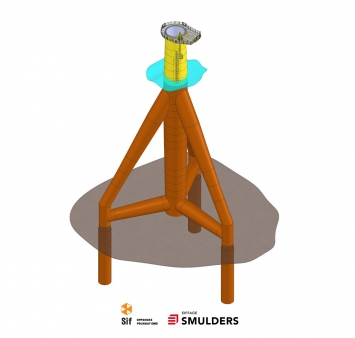newsflash
History of the Tripod
The Tripod was abandoned as a foundation concept a decade ago, having been found to be less competitive compared with a monopile or jacket foundation. It weighed too much in comparison with jackets, and the Tripod manufacturing process was more complex than that of monopiles.
Eventually, the Tripod foundation was replaced in the market by the more cost-efficient monopile foundation for shallow waters, with jackets used in deeper waters or in soil conditions that were unsuitable for monopiles.
Change of context
The last use of the Tripod was about 9 years ago, in the Global Tech 1 wind farm. Its 400 MW capacity was achieved using 80 Tripods in water depths ranging from 38 metres to 41 metres. Nowadays, with more wind farms being built in deeper waters, the playing field for foundations has changed. We now see monopiles being used in water depths of up to 50 to 60 metres and jackets being used as the complementary choice.
In September 2020, Smulders and Sif recognized that the market had neglected the Tripod foundation. This led to an announcement by Sif and Smulders that they would embark on a joint research project to investigate whether – and how – a revival of the Tripod foundation could be made feasible to develop a new Sif-Smulders product line for deeper waters and challenging soil conditions.
Researching the feasibility of the Tripod
The Tripod design offers two main benefits. Firstly, fabricating a Tripod is more cost-efficient than producing a jacket foundation. Secondly, as the Tripod has a more robust construction than a monopile, it has a greater potential for use in deep waters. Smulders and Sif wanted to achieve a Tripod design with a capex-installed similar to a jacket, while setting a target for the Tripod to be built at an output of two units per week.
Despite the various challenges, the feasibility study was successfully concluded in January 2023. The biggest test lays in getting the Tripod’s weight below the set target weight in order to achieve a capex-installed of a comparable jacket, and not so much in creating the right Tripod design for deeper waters.
Having tested different design options to find the one that enabled the Tripod foundation to reach its minimal possible weight without sacrificing the benefits of serial manufacturability, the verdict is that – at today’s steel prices – the Tripod is still approximately 15% more expensive than a comparable jacket. However, based on steel prices prior to the Russia-Ukraine war, this difference can be halved.
Hence, a capex premium of 5 to 15% (approximately a difference of €1 million per foundation) will roughly be applicable compared with a jacket design for the same conditions. Although a premium of approximately €1 million per foundation compared with a jacket design for the same conditions is considerable, it should be noted that the installation costs of a jacket and a Tripod are similar.
Although Smulders developed a serial production methodology that significantly reduced fabrication costs, this does not fully balance out the Tripod’s weight increase and the associated cost.
The Tripod – a niche product
In light of this, the Tripod will be a niche product for specific projects involving challenging soil conditions that are unsuitable for monopiles or other external conditions (e.g. ice loading) that preclude the use of jackets. The northern area of the Baltic Sea is a particularly good example of an area that could feature these challenging environmental conditions and render the Tripod as the foundation of choice.
Challenges in the supply chain may also lead to the Tripod becoming the foundation of choice for specific projects, given that an output of two Tripods per week has proven to be feasible.
The Tripod is revived and ready, and is waiting for the right project to arise.
For more information, please contact tripod@sif-smulders.com.











